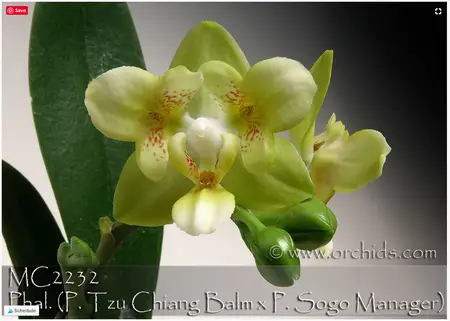
Once you start becoming familiar with orchids, you quickly recognize the structure of three sepals, two petals and a labellum (or lip).
Every once in a while, though, you’ll come across an orchid that doesn’t have that accustomed type of structure. This peculiar orchid seems to be distorted, mutated, or deformed—what we call a peloric orchid.
Whenever an orchid displays a unique structure that clearly strays from the “normal” pattern of orchids, the orchid is classified as peloric. It might have “three lips” or the colors on the lip repeat in the two petals. It could also have “three petals” and no lip. Whatever the case, the orchid seems to deviate the normal pattern of orchid structure.
Peloria usually happens for three reasons:
(1) the orchid was stressed,
(2) it is genetically mutated from the beginning, or
(3) endured environment changes.
The stressor theory hasn’t been proven scientifically, but is a possible explanation for why some orchids produce peloric blossoms one year, but the next, they don’t.
In this article, you’ll learn why this happens and what to expect from next year’s blooms.
Why do peloric orchids form?
When the blossom is still a bud, the lip (or labellum) is forming. In the early stages of development, it is just like another petal, with no difference. Only afterward, later during its formation, the lip differentiates into the unique structure and color it normally portrays.
For some reason in peloric orchids, the genes get unaligned (that’s the best way I can describe it) and the lips and petals take on different routes. It’s a genetic mutation that creates a unique beauty.
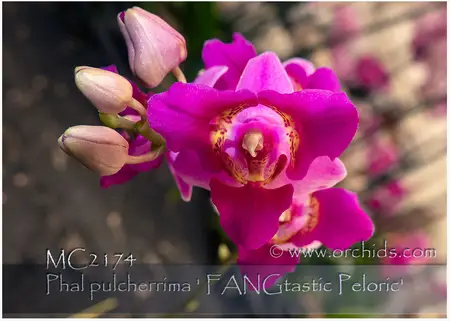
Is a peloric orchid deformed?
Orchids that stray from normality are not deformed, even though some AOS judges may say they are. In some places, because of peloric “deformation”, peloric orchids are not allowed in competitions. Whatever the case, most people would see there is clearly something “wrong” with the orchid.
Here is where the misinformation starts.
There is nothing “wrong” with the orchid. Difference is to be accepted, cherished, and loved. The orchid is not damaged in any way, and otherwise, healthy. Uniqueness is not something to hide, but to be appreciated.
Peloric orchids still have every structure necessary for reproduction and pollination and can carry on their life cycle normally. It might be harder to attract pollinators if the lip imitates the petals, but other than that, your orchid is perfectly healthy. It still is capable of pollination and reproduction.
“Deformity” with peloric orchids is debilitating and not linked to mutations in the column, stem, roots, and other important anatomical parts of the orchid. You can purchase a peloric orchid without fear. It will live just as long as other orchids will.
Meaning of Peloria:
abnormally regular, symmetrical, or, monstrosity?
After all, what does Peloric orchid mean? In Greek, Peloria means a monstrosity, as in huge, big, and oversized from what is usually expected. It has been translated into monster, which doesn’t really explain the orchid at all.
Since the orchids that have peloria aren’t larger than normal or particularly ugly (taste varies from person to person) this term is not quite right. In fact, some peloric orchids never quite open up all the way, and the petals tend to keep closed more than open. This makes them appear smaller.
Peloria also means abnormally regular, which describes the orchid a lot better. The dictionary definition of peloric is “Having a mutation such that a normally asymmetric flower becomes radially symmetric.”
Bilateral vs symmetrical: How to know what to expect from a peloric orchid
If you analyze the structure of the flower, orchids are bilateral. As in a mirror image, what is copied on the right, imitates on the left. Our faces are also bilateral, which is why some authors say humans are so fascinated by orchids. The similarities of an orchid and the human face are parallel; when you look at an orchid, it’s like looking at a human face.
A symmetrical orchid, on the other hand, would display the same number of petals, lips, sepals, and so on… It’s like you cut the orchid in half and repeated the same pattern on the other half. This radical symmetry is created by having three sepals and “three lips”, which happens to be the case in peloria.
Image Credit: Phal. Veitchiana ‘Montclair Peloric'(equestris x schilleriana)at Orchids.com
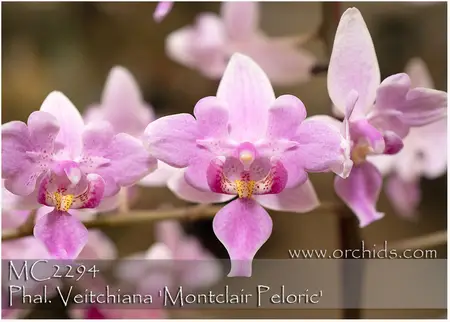
What Kinds of Peloria Exist?
In peloric orchids, the lip pattern is repeated in the petals, either by their form, color, or both. This makes a unique orchid and is very sought after. The mutation has become a stabilized trait passed on from one generation to the next. Many orchid growers sell peloric orchids with three “lips” and they are quite charming.
An example is the variety of Splash Cattleyas, which is a term used to explain the colors that repeat on the two petals, creating a line of vibrant color across the orchid.
In Reverse Peloric orchids, the petal pattern is repeated in the lip, forming what looks like a flower with only petals and no lip. This is somewhat harder to find, and the orchid usually has open, “flat” petals, without the colorful and uniquely shaped lip.
Every once in a while, the orchid will become very unstable and have a bilateral peloria. One petal is normal, and the other imitates the lip. This is extremely hard to find, and usually won’t grow back the next year like this.
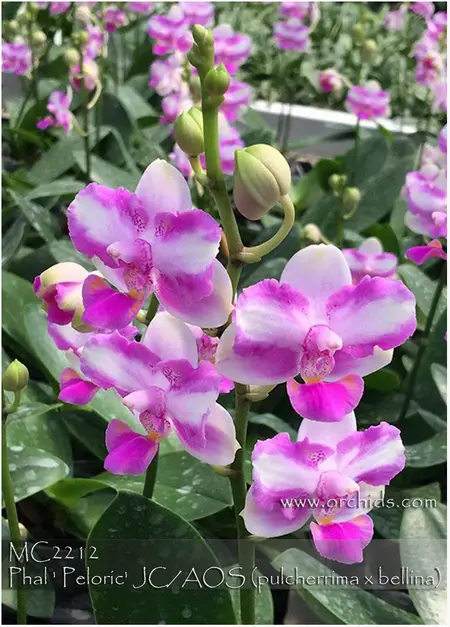
Are Peloric Orchids Stable? Will they rebloom like this again?
To determine if your orchid will rebloom the next year’s blossom with peloria all depends on the cause of the peloria. If it was a stressor, (remember, this theory is not proven) or if it was a reaction to an environmental cause, then most likely your orchid will rebloom naturally next year, without the peloric traits.
In this case, the cause of the peloria that made the orchid react the way it did needs to be identified. Maybe it’s the chemicals in the water? Maybe it’s the variation of light requirements? Lack of humidity? All conspiracy theories are applicable here… 🙂
Yet, some other orchids are cloned and grown to recreate the peloria year after year. In this case, the genetic mutation is stable and desired. These orchids have found a special place in nurseries and will bloom with peloria. Their keikis will also produce peloric tendencies. If you ordered a peloric orchid from an established grower, there is 100% chance that this orchid will rebloom with peloria. The trait is genetically established and stable.
On the other hand, if you pick a big box, grocery store, or supermarket orchid and notice it is peloric, it’s more than probable that this trait will not carry out into the next year’s bloom. Even though there is a slight possibility, it’s not likely. This is what we call an unstable trait.
Either way, make sure you are pleased with the peloria, since the orchid may rebloom the next year with another spike full of peloric blossoms—or not.
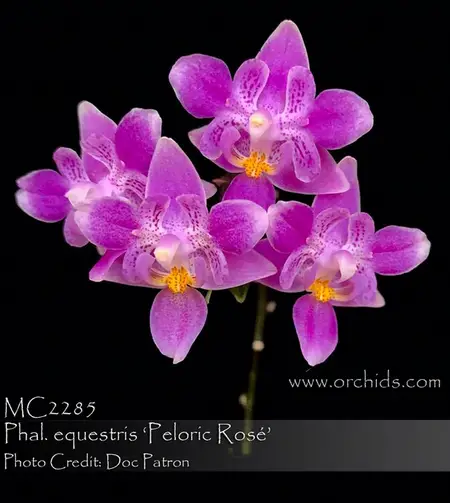
Is a Peloric Orchid Worth Buying?
This, I cannot answer. If you’re scared that the orchid will not live to see the next months because it’s sick, damaged, or deformed; or that it might be harder to cultivate, then don’t worry. Peloric orchids are just as healthy as the non-peloric ones.
It all comes down to the taste in what you want our flowers to look like.
I personally love the peloric orchids where the petals all have mutated into lips, forming a delicately awesome orchid to look at. Yet, on the other hand, I don’t find reverse peloria to be pretty, since the lip structure is not present, the petals are flat, and it doesn’t stand out to me as an orchid.
I tend to look at reverse peloric orchids as just another flower, not any different. In my mind, it lacks the uniqueness that makes the orchid an orchid. It all comes down to the unique structure of the lip…But this is personal taste.
Don’t Stop Learning!
If you want to be included in more information and get a 14-page fertilization guide, please sign up for my newsletter. I don’t spam, but send emails out bi-monthly with some curious topics of interest. If you want more information, click here to go to a specific page on this website where I explain it more in detail.

Also, if you are looking for an orchid journal to keep your notes specifically about orchid care, check out my 2 solutions for that on this page. If note-keeping isn’t your thing, then there is a free excel spreadsheet that you can download. Click here for more information on how to do that.
If you subscribe to my newsletter, I will send you a 14-page guide on the main tips of orchid fertilizer. It is downloadable and you can print it out on your computer. I designed the guide to double up as a coloring book, just to make it fun.
You have to go with what makes the orchid attractive to you.There are several orchid sellers and nurseries who commercialize peloric orchids. If you’re looking into buying one, first check out this page which has recommended orchid sellers and tips and secrets of how to choose a nursery that will deliver what it promises.
Happy Cultivating!


So in conclusion, is a splash dendrobium a peloric dendrobium. I purchased the most beautiful Dendrobium Dawn Maree (splash/peloric) large plant. It is awesome. I am going to send you an email with pictures attached.
My name is Greg Janick and I am an American living in Chiang Mai Thailand. Thanks for your valuable time.